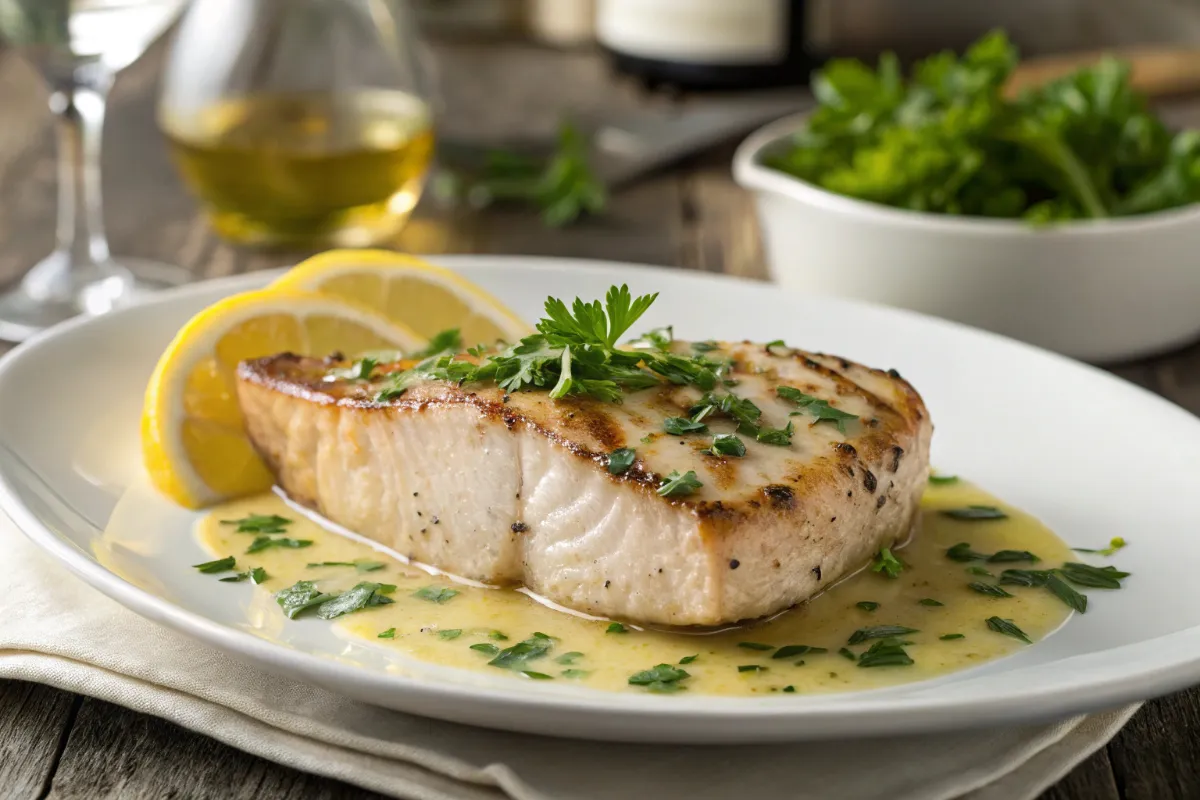How to Cook Perfect Swordfish recipe at Home
Swordfish, with its firm, meaty texture and mildly sweet flavor, stands out as a versatile and delicious option for seafood lovers. Often likened to a steak of the sea, it holds up beautifully to various cooking methods, from grilling to pan-searing. This swordfish recipe guide will, therefore, transform you into a confident cook capable of preparing perfect swordfish every single time.
Whether you’re a seasoned chef or just beginning your culinary journey, understanding how to select, prepare, and cook this magnificent fish is key to a successful swordfish recipe. Moreover, the American Heart Association highlights the benefits of eating fish, like swordfish, rich in omega-3 fatty acids, contributing positively to heart health. We’ll cover everything you need to know about creating the perfect swordfish recipe, consequently ensuring your swordfish dishes are consistently moist, flavorful, and impressive.
Swordfish consistently ranks as a favorite among those who appreciate a substantial, flavorful fish. Unlike more delicate white fish, swordfish boasts a distinctively meaty texture, often drawing comparisons to beef tenderloin. The flavor profile is, in fact, remarkably mild and slightly sweet, lacking the strong “fishy” taste that can deter some eaters. This makes it an excellent canvas for a wide array of seasonings and sauces in any swordfish recipe.
Its robust structure means it won’t easily flake or fall apart, making it ideal for methods that might challenge more delicate fish. Furthermore, swordfish cooks relatively quickly—a delicious swordfish recipe can often be ready in 10-15 minutes—making it perfect for weeknight dinners. Additionally, it’s also a fantastic source of lean protein, essential vitamins like D and B12, and omega-3 fatty acids.
Table of Contents
Selecting Quality Swordfish: The Ultimate Buyer’s Guide
Choosing high-quality swordfish is undoubtedly the first crucial step towards a delicious meal. Whether opting for fresh or frozen, certain indicators can guide your selection for your swordfish recipe.
Fresh Swordfish:
- Look For: Bright, vibrant flesh (color varies but avoid brown/dull), firm texture, clean ocean smell, moist appearance.
- Avoid: Strong fishy odor, soft or mushy texture, discoloration, dryness or sliminess.
Frozen Swordfish:
- Look For: Vacuum-sealed packaging, no signs of freezer burn (ice crystals inside package, discoloration).
- Tip: High-quality frozen swordfish is, in fact, often better than mediocre fresh swordfish for your recipe.
Your senses are your best tools when selecting swordfish. Pay close attention to these details, as recommended by the FDA guidelines for selecting and serving seafood safely:
- Color: Look for flesh that is bright and translucent, ranging from ivory-white to pinkish.
- Smell: Fresh swordfish should smell clean and briny, like the ocean.
- Texture: It should feel firm and spring back when gently pressed.
Ideally, choose steaks that are between 1 and 1.5 inches thick for your swordfish recipe. This thickness provides several advantages:
- Easier to Cook: Thicker steaks are more forgiving, thus allowing you to achieve a good sear without overcooking the center.
- Better Moisture Retention: Thicker cuts help retain internal moisture, consequently resulting in a juicier swordfish.
- More Consistent Results: Cooking times are, as a result, more predictable with uniformly thick steaks.
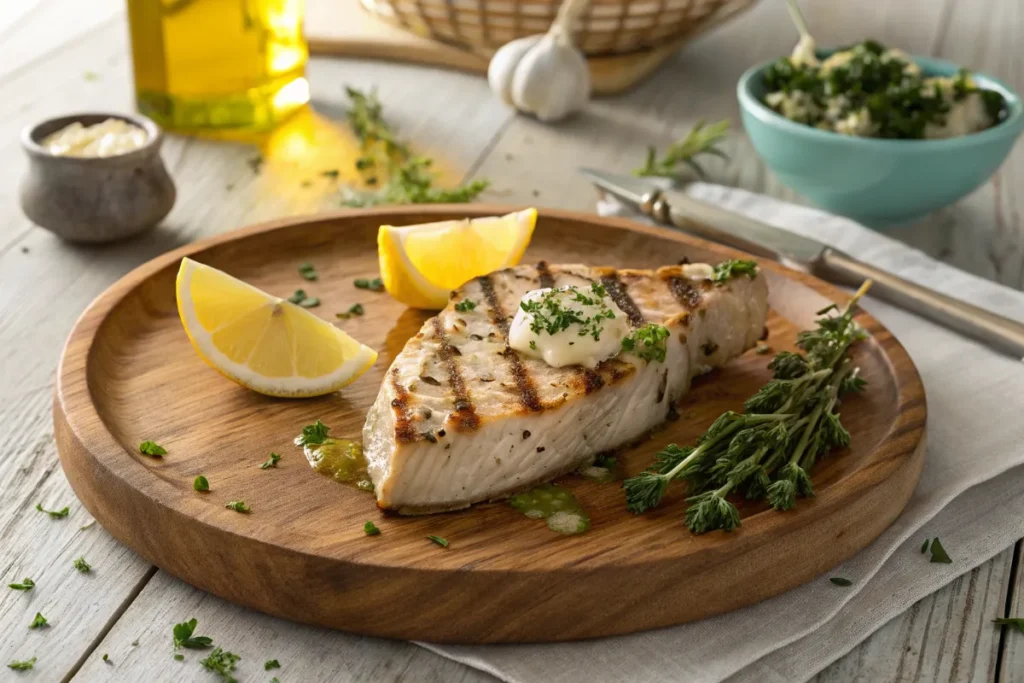
Essential Prep Work: Setting Your Swordfish Up for Success
Proper preparation is, without doubt, just as important as selecting good quality fish. These simple pre-cooking steps are fundamental for achieving the best texture and flavor in any swordfish recipe.
If you’re starting with frozen swordfish, safe thawing is crucial:
- Refrigerator Thawing (Best Method): Place the vacuum-sealed fish on a plate in the refrigerator for 8-12 hours, or overnight.
- Cold Water Thawing (Faster Method): Alternatively, keep the fish in its airtight packaging and submerge in cold water. Change the water every 30 minutes. A 1-inch thick steak might thaw in about an hour.
Thoroughly patting your swordfish steaks dry with paper towels before seasoning or cooking is absolutely essential for a successful swordfish recipe. Why is drying so important?
- Promotes Searing: Moisture creates steam when it hits a hot pan, therefore preventing proper browning.
- Prevents Sticking: A drier surface is, as a result, less likely to stick to the cooking surface.
- Better Texture: Eliminating excess water helps, in addition, achieve a firmer texture.
For seasoning, while complex marinades are an option, the fundamentals involve just salt, pepper, and a bit of oil:
- Salt and Pepper: Season generously on all sides just before cooking. Use kosher salt or sea salt and freshly ground black pepper.
- Oil: Lightly brush the steaks with oil (olive oil or a higher smoke point oil like avocado for high-heat cooking).
Master These Cooking Methods for Delicious Swordfish
Cooking a perfect swordfish recipe is straightforward once you understand the best techniques. Here’s how to master the most popular approaches.
Pan-Searing Technique: Achieving the Perfect Golden Crust
Pan-seared swordfish is a favorite for its speed and the delicious crust it develops. In fact, many chefs consider this the ultimate way to prepare a quick swordfish meal. If you enjoy this technique, you might also love our best steak bites recipe which uses similar high-heat searing methods for perfect caramelization.
Steps for Pan-Searing:
- Preheat Pan: First, use a heavy-bottomed skillet over medium-high heat. Add just enough high-smoke-point oil to coat the bottom.
- Ensure Oil is Hot: Next, wait until the oil shimmers slightly.
- Sear Fish: Then, place the patted-dry, seasoned steaks in the hot pan. Don’t overcrowd it. Cook undisturbed for 3-5 minutes per side (for 1-inch steaks) until a golden-brown crust forms.
- Check Doneness: Subsequently, use an instant-read thermometer (aiming for 130-140°F internally) or check if the fish flakes easily but is still moist inside.
- Rest: Finally, remove from pan and let rest for a few minutes before serving.
Grilling Method: Creating Amazing Smoky Flavor
Grilled swordfish offers wonderful smoky flavor and attractive grill marks. Additionally, this method is perfect for outdoor cooking during warmer months and creates a memorable swordfish recipe.
Steps for Grilling:
- Preheat Grill: To begin with, heat your grill to medium-high heat.
- Clean and Oil Grates: Next, clean the grill grates thoroughly, then oil them generously.
- Prepare Fish: After that, pat the swordfish dry and brush lightly with oil before seasoning.
- Grill: Subsequently, place steaks on the hot, oiled grates. Grill for 4-6 minutes per side (for 1-inch steaks), flipping only once if possible.
- Rest: Finally, let the fish rest off the grill for 5 minutes.
Baking Swordfish: Your Recipe Route to Moist, Tender Results
Baked swordfish is reliable for achieving consistently moist and tender results. Furthermore, this method works exceptionally well when cooking for a crowd. For those who enjoy experimenting with different cooking methods, our crispy air fryer chicken nuggets recipe offers another technique that could be adapted for smaller pieces of swordfish.
Steps for Baking:
- Preheat Oven: First of all, set your oven between 375°F and 425°F (190°C to 220°C).
- Prepare Fish: Then, place seasoned swordfish steaks in a lightly oiled baking dish.
- Bake: Next, cook for approximately 10-15 minutes per inch of thickness.
- Check Doneness: Finally, test with a thermometer (135-145°F) or check for flakiness and opacity.
Signature Easy Swordfish Recipe: Pan-Seared with Lemon-Garlic Butter
Now let’s put these techniques into practice with a signature easy swordfish recipe. Indeed, this dish combines simplicity with restaurant-quality results.
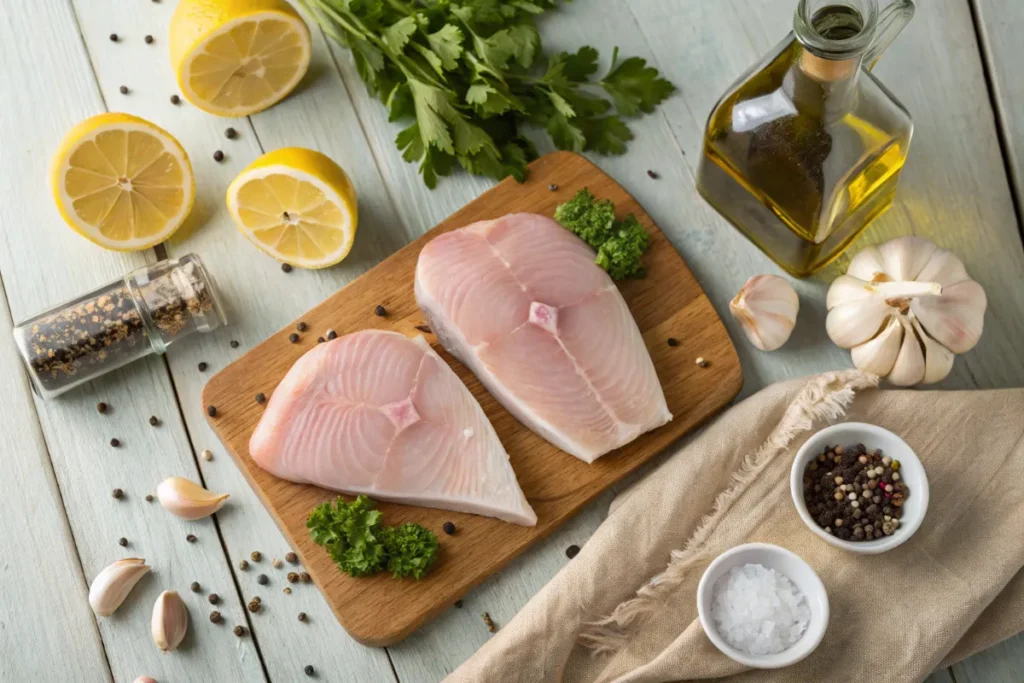
Ingredients You’ll Need for This Classic Preparation
| Ingredient | Quantity | Notes |
|---|---|---|
| Swordfish Steaks | 2 (6-8 oz each) | ~1-1.5 inches thick |
| Olive Oil or Avocado Oil | 1-2 Tablespoons | For searing |
| Unsalted Butter | 3 Tablespoons | Divided |
| Garlic | 2-3 cloves | Minced |
| Fresh Lemon Juice | 2 Tablespoons | (~1/2 lemon) |
| Fresh Parsley | 1 Tablespoon | Chopped (plus more for garnish) |
| Salt and Pepper | To taste | Kosher or sea salt preferred |
Step-by-Step Swordfish Cooking Instructions for Perfect Results
- Prepare the Swordfish: First, remove steaks from refrigerator 15-20 minutes before cooking. Then, pat thoroughly dry with paper towels. Finally, season generously with salt and pepper.
- Heat the Pan: To begin with, place a heavy-bottomed skillet over medium-high heat. Subsequently, add 1 tablespoon of oil and heat until shimmering.
- Sear the Swordfish: Next, place the steaks in the hot pan, ensuring they don’t touch. Sear undisturbed for 3-5 minutes until a golden-brown crust forms.
- Flip and Add Butter: After that, gently flip the steaks. Add 1 tablespoon of butter to the pan. As it melts, baste the fish with the butter for about 30 seconds.
- Continue Cooking: Then, reduce heat slightly. Cook for another 2-4 minutes, depending on thickness. Use a thermometer to check for doneness (130-135°F for medium-rare, 140-145°F for medium/well).
- Rest Fish: Subsequently, transfer to a plate and tent loosely with foil. Let rest for 5 minutes.
- Make the Sauce: Meanwhile, return the pan to medium-low heat. Add remaining 2 tablespoons of butter. Once melted, add garlic and sauté for 30-60 seconds until fragrant.
- Finish Sauce: Furthermore, add lemon juice, scraping up any browned bits. Cook for 30 seconds, then remove from heat and stir in parsley.
- Serve: Finally, spoon the sauce over the rested swordfish and serve immediately.
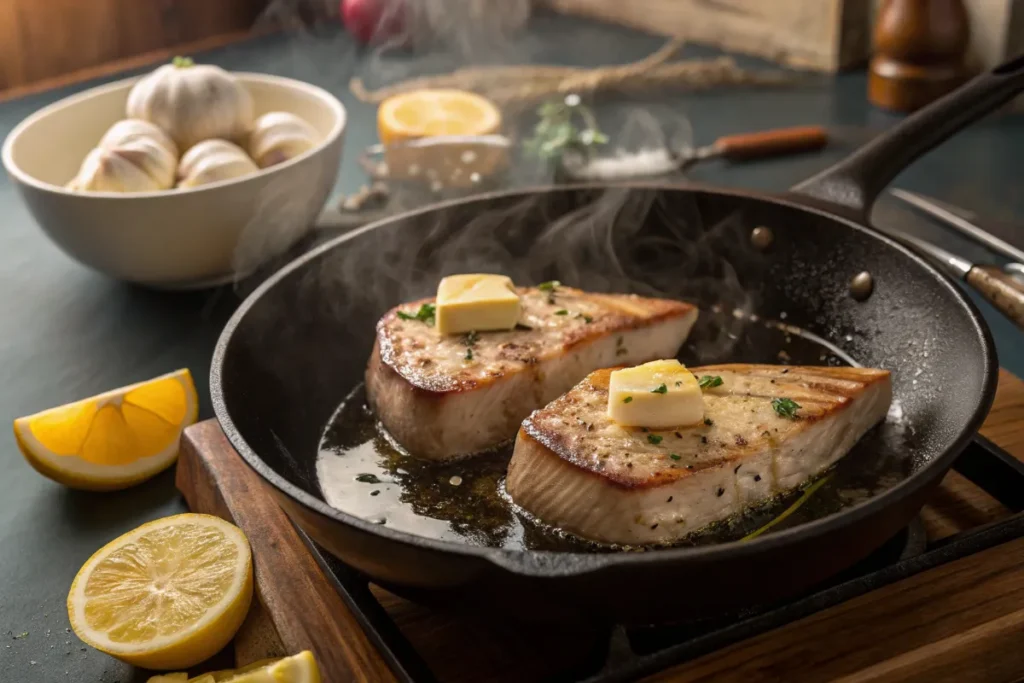
Tips for Perfect Results Every Time
- Don’t Overcrowd: Above all, cook steaks in batches if necessary.
- Manage Heat: Additionally, adjust as needed to prevent burning.
- Doneness is Key: Most importantly, use a thermometer for accuracy to avoid dry fish.
Pro Tips for Cooking Tender, Juicy Swordfish Steaks Every Time
The primary reason for dry swordfish in any swordfish recipe is, without a doubt, overcooking. Swordfish cooks quickly, and consequently, the window between perfectly cooked and unpleasantly dry is narrow.
Visual Cues for Doneness:
- The flesh will turn from translucent to opaque.
- It should, moreover, flake easily when gently prodded with a fork, but still retain moisture.
- Avoid cooking until it’s completely white and chalky throughout.
Target Internal Temperatures:
- 130-135°F (54-57°C): Medium-Rare to Medium. Center will be slightly pink and very moist.
- 140-145°F (60-63°C): Medium-Well to Well-Done. Fully opaque, flakes easily.
Allowing cooked swordfish to rest for about 5 minutes before cutting or serving is highly recommended for any swordfish recipe. This allows, therefore, the muscle fibers to relax and the juices to redistribute evenly throughout the steak.
Swordfish Nutrition: Health Benefits and Considerations
Is swordfish good for you? Yes, from a nutritional standpoint, it certainly packs a powerful punch. A typical 3.5-ounce (100g) serving provides:
- Protein: ~20-26 grams of high-quality, complete protein
- Omega-3 Fatty Acids: Significant source, crucial for heart and brain health
- Vitamins: Excellent source of Vitamin D, Vitamin B12, and Niacin
- Minerals: Rich in Selenium and a good source of Magnesium and Potassium
The primary health consideration is, however, mercury content. As a large predatory fish, swordfish accumulates more methylmercury than smaller fish. According to Harvard’s research on mercury levels in seafood , consumption should be limited to one serving per week for the general population, with pregnant women and young children being more cautious.
If you’re looking for seafood options with lower mercury content, our best salmon cake recipe offers a delicious alternative that’s both crispy and flaky.
Common Questions About Cooking Swordfish: FAQs
How do I know when swordfish is cooked? Look for visual cues: the flesh should turn from translucent to opaque and flake easily when gently pressed with a fork. For guaranteed accuracy, however, use an instant-read thermometer aiming for 130-145°F when preparing your swordfish recipe.
Why is my swordfish resulting in dry fish, and how can I prevent it? The most common cause is, without question, overcooking. Choose thicker steaks, use a thermometer, cook quickly, and allow the fish to rest after cooking for the best swordfish recipe results.
What does swordfish taste like? Swordfish has a mild flavor, often described as slightly sweet and clean. Its texture is distinctively meaty and firm, similar to a pork chop or beef steak, rather than flaky like other fish.
What is the best way to cook swordfish? There isn’t one single “best” way. Popular methods include, for instance, grilling (for smoky flavor), pan-searing (for a crispy crust), and baking (for gentle, even cooking). The best swordfish recipe depends on your preferences and equipment.
Should swordfish be marinated? Marinating is optional but can add flavor and moisture. If using an acidic marinade (like lemon juice), keep the time short (15-30 minutes) to prevent the acid from altering the texture too much.
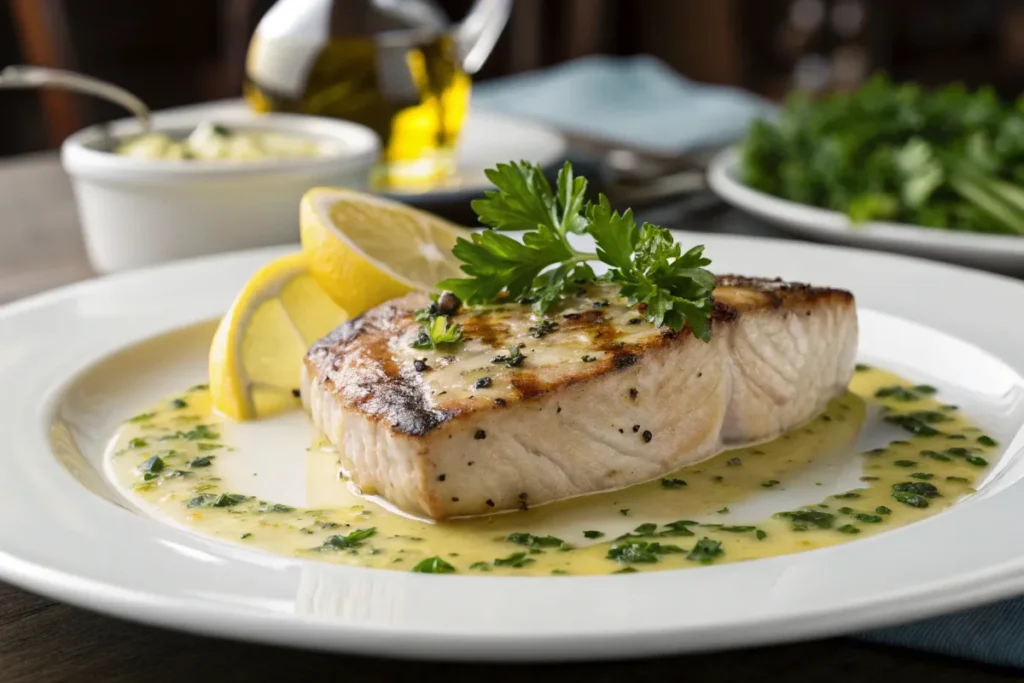
Conclusion: Your Journey to Swordfish Mastery
Cooking a delicious swordfish recipe at home doesn’t need to be intimidating. By understanding how to choose the best steaks, prepare them correctly, master key cooking techniques, and crucially, avoid overcooking, you can consistently create delicious, moist, and flavorful swordfish dishes.
In conclusion, remember the importance of patting the fish dry, using accurate temperatures, and allowing the fish to rest in your swordfish recipe. Embrace the versatility of swordfish by experimenting with different flavors and cooking methods. Whether you choose a simple pan-sear with lemon butter or an adventurous grilled preparation, the results are, ultimately, sure to impress.
For a complete seafood dinner experience, consider pairing your swordfish with our shrimp fried rice as a delicious side dish. And if you’re looking to explore more elegant seafood preparations, our crab brulee recipe offers another sophisticated option for your next special occasion.

